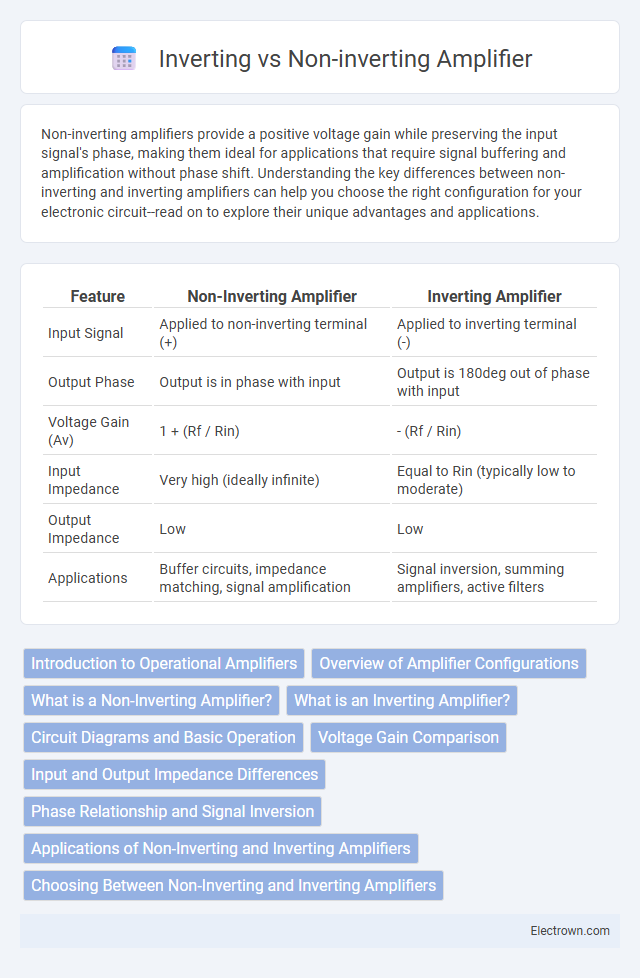Non-inverting amplifiers provide a positive voltage gain while preserving the input signal's phase, making them ideal for applications that require signal buffering and amplification without phase shift. Understanding the key differences between non-inverting and inverting amplifiers can help you choose the right configuration for your electronic circuit--read on to explore their unique advantages and applications.
Table of Comparison
| Feature | Non-Inverting Amplifier | Inverting Amplifier |
|---|---|---|
| Input Signal | Applied to non-inverting terminal (+) | Applied to inverting terminal (-) |
| Output Phase | Output is in phase with input | Output is 180deg out of phase with input |
| Voltage Gain (Av) | 1 + (Rf / Rin) | - (Rf / Rin) |
| Input Impedance | Very high (ideally infinite) | Equal to Rin (typically low to moderate) |
| Output Impedance | Low | Low |
| Applications | Buffer circuits, impedance matching, signal amplification | Signal inversion, summing amplifiers, active filters |
Introduction to Operational Amplifiers
Operational amplifiers (op-amps) are fundamental components in analog electronics, used to amplify voltage signals with high gain and stability. Non-inverting amplifiers provide output signals that are in phase with the input, while inverting amplifiers produce output signals that are 180 degrees out of phase. Your choice between these configurations depends on the desired signal polarity and input impedance characteristics for your specific application.
Overview of Amplifier Configurations
Non-inverting and inverting amplifiers are fundamental operational amplifier configurations used to control signal gain and phase. The non-inverting amplifier provides a positive gain with the output signal in phase with the input, while the inverting amplifier produces a gain with the output signal 180 degrees out of phase. Understanding these configurations helps optimize your circuit design for specific amplification and signal conditioning applications.
What is a Non-Inverting Amplifier?
A non-inverting amplifier is an operational amplifier configuration where the input signal is applied to the non-inverting terminal, resulting in an output signal that is in phase with the input. This amplifier provides a high input impedance and a voltage gain determined by the ratio of the feedback resistor to the input resistor plus one. Commonly used in signal conditioning, non-inverting amplifiers maintain signal integrity and produce stable amplification with minimal distortion.
What is an Inverting Amplifier?
An inverting amplifier is an operational amplifier configuration that reverses the input signal's polarity, producing an output voltage proportional to the negative of the input voltage. It is characterized by a negative voltage gain determined by the ratio of two resistors, which sets the amplification factor precisely. Your circuit's input impedance is low, making it ideal for certain signal processing applications where phase inversion and gain control are required.
Circuit Diagrams and Basic Operation
Non-inverting amplifiers feature the input signal applied to the non-inverting terminal of the operational amplifier, resulting in an output that is in phase with the input, and their circuit diagram includes a feedback resistor network between the output and inverting input. Inverting amplifiers have the input signal connected to the inverting terminal through an input resistor, with the non-inverting terminal typically grounded, producing an output phase inversion relative to the input; their circuit diagram displays resistors forming a voltage divider for gain control. Both configurations rely on negative feedback to stabilize gain and ensure linear amplification in analog signal processing applications.
Voltage Gain Comparison
Non-inverting amplifiers provide a voltage gain defined by the formula \(1 + \frac{R_f}{R_{in}}\), allowing the output to remain in phase with the input signal. Inverting amplifiers have a voltage gain of \(-\frac{R_f}{R_{in}}\), resulting in an output that is 180 degrees out of phase with the input. Your choice between these configurations depends on whether phase inversion impacts your voltage amplification requirements.
Input and Output Impedance Differences
Non-inverting amplifiers typically offer high input impedance, often in the megaohm range, which minimizes signal source loading and preserves signal integrity. Inverting amplifiers have low input impedance, usually determined by the input resistor, making them more susceptible to loading effects. Your choice between these amplifier types should consider these impedance characteristics to match source and load requirements effectively.
Phase Relationship and Signal Inversion
Non-inverting amplifiers maintain the input signal's phase, producing an output that is in phase with the input voltage, resulting in zero degrees phase shift. In contrast, inverting amplifiers reverse the input signal's polarity, creating a 180-degree phase shift between input and output signals. This phase inversion is crucial for applications requiring signal phase control or feedback stability in operational amplifier circuits.
Applications of Non-Inverting and Inverting Amplifiers
Non-inverting amplifiers are commonly used in sensor signal conditioning, audio amplification, and buffer stages due to their high input impedance and phase-preserving output. Inverting amplifiers find applications in active filters, analog computation, and signal inversion tasks, offering precise gain control and phase inversion. Your choice between these amplifiers depends on the required input impedance, phase relationship, and specific circuit functionality.
Choosing Between Non-Inverting and Inverting Amplifiers
Choosing between non-inverting and inverting amplifiers depends on your desired signal phase and input impedance requirements. Non-inverting amplifiers provide high input impedance and maintain signal phase, making them ideal for buffering and sensor applications. Inverting amplifiers offer phase inversion and precise gain control with lower input impedance, suited for signal processing where phase reversal is acceptable.
Non-inverting vs Inverting Amplifier Infographic

 electrown.com
electrown.com